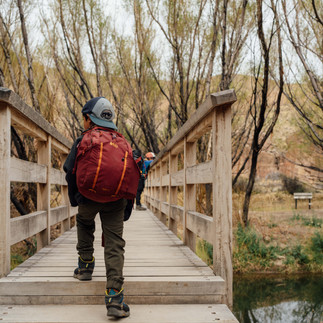What They'll Remember: Teaching Wonder in a Wild World
- courtney cadenhead
- Apr 7
- 4 min read

We crossed the border into Argentina with anticipation buzzing quietly beneath the surface. Much of this journey we've left open, letting the road decide what comes next. But this part—I had planned. I had waited. I wanted to show my children the Cueva de las Manos, the Cave of Hands.
Our timing was off that day, and we reached Bajo Caracoles—a tiny, wind-blown town in the middle of nowhere—too late to get to the park before nightfall. We had to pivot. There were only two small hostels in town, both offering the most basic of comforts. I remember crying that night. I had wanted everything to be just right for my kids. I knew the tears were small and silly in the grand scheme of things, but Jorge held me until I let the disappointment pass. We slept in beds instead of a tent, and in the morning, we drove on.

The Patagonia National Park in Argentina shares the same breathtaking vastness as the Chilean side—wide open steppes, wind, dry grasses, small hills. We saw a flamingo feeding in a nearby lagoon as we arrived and set up our tent inside a ring of wooden posts—an unspoken promise of strong winds to come. Rather than drive, we chose to walk the ravine that leads to the Cave of Hands, winding our way through one of the few places in the park where water runs. The deeper we walked into the canyon, the more the desert softened. Trees appeared. A river came into view. It reminded me of the American Southwest, a place I’ve never known well, but suddenly began to understand. So barren, and yet so alive.


My children walked like explorers—no complaints, just wonder. Pointing out small bugs. Talking nonstop. Jumping over rocks. The caves, when we reached them, felt like an echo from the past.
Cueva de las Manos is one of South America's most extraordinary archaeological sites. It contains stenciled handprints, paintings of animals and hunting scenes, and abstract patterns—many dating back nearly 10,000 years. Created by the ancestors of the Tehuelche people, the paintings were made using natural mineral pigments and sprayed over hands pressed against the rock walls, often with bone pipes. It is believed these works were part of rituals or initiation rites, expressions of identity and belonging. They are declarations: “We were here.”
Before the tour began, we sat at a wooden table and devoured our milanesa sandwiches—Argentina’s national version of comfort food: breaded meat, cheese, tomato, lettuce, and bread. When our group was called, we put on helmets and followed the guide along the cliffside path.

I was thrilled. I remembered the cave paintings of Lascaux in France that my mother had shown me when I was a child, and later, studying these same images in art school. I remembered the academic debates: Was this just prehistoric graffiti? Language? Ceremony? I’ve always been drawn to mysteries, to the way humans leave traces of themselves behind. I wanted my sons to feel that same awe, that same spark of wonder.

Of course, the reality wasn’t exactly as I had imagined. The boys were hot and thirsty and a little impatient with the tour. But on the walk back through the canyon, we stopped by the river, and they began climbing the canyon walls, laughing, improvising games. I stood still, listening to the wind, watching the light on the rock, and felt nothing but gratitude.
They might not remember the cave. But something will stay. Something will leave a mark on them, just like those handprints on the stone left marks across time. Maybe it’s not archaeology for them. Maybe it’s climbing, or insects, or the act of cooking rice out of the back of our car. I don’t know what it will be, but I believe something from this journey will shape them.

As parents, we try to give what we love. Sometimes we get it right. Sometimes not. But the act of giving is still everything. This trip is my gift to them—not because I am the most patient or attentive or traditionally nurturing—but because I can give them the world. I can open the door. I can say, “Look. Isn’t this marvelous?”
And if they choose to keep walking, to keep wondering—that is more than enough.
The day we left the park, my son looked out the car window and said, “I don’t think I want to save up for a Nintendo Switch anymore. I’m going to save to go on a trip around the world with my brother when I’m 18.”
“Oh, really?” I replied, trying to sound casual, not to give away the pride swelling inside me. But in that moment, I thought: my work is done. What I had hoped for happened faster than I ever expected.
I am grateful we made this decision. That we trusted ourselves. That we bet on this dream and followed through. The wind has been strong, the setbacks real, but the wonder? The wonder is stronger.





























Comments